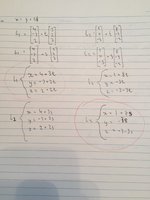Linear intersection
- Thread starter Leo79
- Start date
HallsofIvy
Elite Member
- Joined
- Jan 27, 2012
- Messages
- 7,763
What you have done is correct although it is a little peculiar that you write the vector equations in terms of "t" but have the parametric equations in terms of "s"!
For the second part, determining where the lines intersect, you want to use different variables, say, for l1,
x= 4+ 3t
y= -7+ 2t
z= 2+ 2t
and, for l2,
x= 1+ 8s
y= -3s
z= -3- 3s
At a point of intersection the x, y, and z must be the same:
x= 4+ 3t= 1+ 8s
y= -7+ 2t= -3s
z= 2+ 2t= -3- 3s.
That is three equations in only two unknowns so you can solve the first two equations for s and t and then see if those values satisfy the third one. That is because, in three dimensions, two line do NOT in general intersect.
For the second part, determining where the lines intersect, you want to use different variables, say, for l1,
x= 4+ 3t
y= -7+ 2t
z= 2+ 2t
and, for l2,
x= 1+ 8s
y= -3s
z= -3- 3s
At a point of intersection the x, y, and z must be the same:
x= 4+ 3t= 1+ 8s
y= -7+ 2t= -3s
z= 2+ 2t= -3- 3s.
That is three equations in only two unknowns so you can solve the first two equations for s and t and then see if those values satisfy the third one. That is because, in three dimensions, two line do NOT in general intersect.
Oh okay thank you - Could I put these equations into a matrix form and reduce it to row echelon form? If so how do I start the matrix associated with these equations?What you have done is correct although it is a little peculiar that you write the vector equations in terms of "t" but have the parametric equations in terms of "s"!
For the second part, determining where the lines intersect, you want to use different variables, say, for l1,
x= 4+ 3t
y= -7+ 2t
z= 2+ 2t
and, for l2,
x= 1+ 8s
y= -3s
z= -3- 3s
At a point of intersection the x, y, and z must be the same:
x= 4+ 3t= 1+ 8s
y= -7+ 2t= -3s
z= 2+ 2t= -3- 3s.
That is three equations in only two unknowns so you can solve the first two equations for s and t and then see if those values satisfy the third one. That is because, in three dimensions, two line do NOT in general intersect.
HallsofIvy
Elite Member
- Joined
- Jan 27, 2012
- Messages
- 7,763
You could- but for a system of two equations in two unknowns, that is usually "overkill". Matrices are usually intended for much larger systems.
The equations I arrived at are
x= 4+ 3t= 1+ 8s
y= -7+ 2t= -3s
z= 2+ 2t= -3- 3s
which are the same as
8s- 3t= 3
3s+ 2t= 7
3s+ 2t=-5
And I can immediately see that there is no solution- 3s+ 2 cannot be equal to both 7 and -5!
If you really wanted to write this as a matrix equation then it would be ⎣⎢⎡833−322⎦⎥⎤[st]=⎣⎢⎡37−5⎦⎥⎤.
Writing it as an "augmented matrix" we would have
⎣⎢⎡833−32237−5⎦⎥⎤.
I doubt that "row reduction" will help but if we did we would have ⎣⎢⎡100−8310832561−835⎦⎥⎤
and that last row tells us that this is impossible.
The equations I arrived at are
x= 4+ 3t= 1+ 8s
y= -7+ 2t= -3s
z= 2+ 2t= -3- 3s
which are the same as
8s- 3t= 3
3s+ 2t= 7
3s+ 2t=-5
And I can immediately see that there is no solution- 3s+ 2 cannot be equal to both 7 and -5!
If you really wanted to write this as a matrix equation then it would be ⎣⎢⎡833−322⎦⎥⎤[st]=⎣⎢⎡37−5⎦⎥⎤.
Writing it as an "augmented matrix" we would have
⎣⎢⎡833−32237−5⎦⎥⎤.
I doubt that "row reduction" will help but if we did we would have ⎣⎢⎡100−8310832561−835⎦⎥⎤
and that last row tells us that this is impossible.

